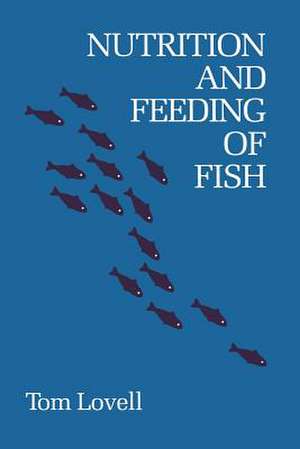Nutrition and Feeding of Fish
Autor Tom Lovellen Limba Engleză Paperback – 16 dec 2012
| Toate formatele și edițiile | Preț | Express |
|---|---|---|
| Paperback (2) | 578.19 lei 6-8 săpt. | |
| Springer Us – 16 dec 2012 | 578.19 lei 6-8 săpt. | |
| Springer Us – 25 sep 2012 | 2470.00 lei 6-8 săpt. | |
| Hardback (1) | 2498.94 lei 6-8 săpt. | |
| Springer Us – 30 noi 1998 | 2498.94 lei 6-8 săpt. |
Preț: 578.19 lei
Preț vechi: 680.22 lei
-15% Nou
Puncte Express: 867
Preț estimativ în valută:
110.63€ • 115.51$ • 91.57£
110.63€ • 115.51$ • 91.57£
Carte tipărită la comandă
Livrare economică 04-18 aprilie
Preluare comenzi: 021 569.72.76
Specificații
ISBN-13: 9781475711769
ISBN-10: 147571176X
Pagini: 260
Ilustrații: XI, 260 p.
Dimensiuni: 152 x 229 mm
Greutate: 0.41 kg
Ediția:1st ed. 1989
Editura: Springer Us
Colecția Springer
Locul publicării:New York, NY, United States
ISBN-10: 147571176X
Pagini: 260
Ilustrații: XI, 260 p.
Dimensiuni: 152 x 229 mm
Greutate: 0.41 kg
Ediția:1st ed. 1989
Editura: Springer Us
Colecția Springer
Locul publicării:New York, NY, United States
Cuprins
1 The Concept of Feeding Fish.- Evolution of Aquaculture.- Necessity of Feeding Fish.- Comparison of Feeding Fish and Land Animals.- Fish Versus Farm Animals as Animal Protein in Human Diets.- Levels of Fish Culture.- 2 The Nutrients.- Energy Requirements and Sources.- Proteins and Amino Acids.- Vitamins.- Essential Lipids.- Minerals.- 3 Digestion and Metabolism.- Digestion.- Measuring Nutrient Digestibility in Fish.- Metabolism.- Rate of Metabolism (Oxygen Consumption) in Fish.- 4 Nonnutrient Diet Components.- Toxins and Antimetabolites.- Diet Additives.- Accidental Contaminants.- 5 Feed Formulation and Processing.- Formulating Fish Feeds.- Practical Feed Ingredients.- Processing Fish Feeds.- 6 Fish Feeding Experiments.- Controlled Environment Studies.- Practical Environment Studies.- 7 Practical Feeding — Channel Catfish.- Feeding Practices.- Nutritional Requirements of Channel Catfish.- Importance of Natural Foods in Catfish Ponds.- Effect of Fish Size on Feeding Responses.- Compensatory Growth in Channel Catfish.- Effects of Feed on Sensory Qualities of Processed Catfish.- Feeding Brood Fish.- 8 Practical Feeding—Tilapias.- Culture Practices.- Nutrient Requirements.- Feeds and Feeding.- 9 Practical Feeding—Salmon and Trout.- Types of Salmonid Culture.- Production of Seedstock.- General Culture Methods.- Nutrient Requirements.- Feed Formulation.- Feeding Practices.- 10 Practical Feeding—Penaeid Shrimps.- Culture Practices.- Nutrient Requirements.- Feeds and Feeding.- Practical Feeds.- 11 Practical Feeding—Eels.- Culture Methods.- Nutritional Requirements.- Feed Preparation.- Feeding Practices.- Daily Feeding Rate.- Research Needs.- 12 Practical Feeding—Crawfish.- Culture.- Feeding Behavior.- Providing Natural Foods for Crawfish.- Supplemental Feeding.- Nutrient Requirements.- Appendix A Composition of Feed Ingredients.- Appendix B Common and Scientific Names of Species.
Descriere
Descriere de la o altă ediție sau format:
Aquaculture is now recognized as a viable and profitable enterprise worldwide. As aquaculture technology has evolved, the push toward higher yields and faster growth has involved the enhancement or replacement of natural foods with prepared diets. In many aquaculture operations today, feed accounts for more than one-half the variable operating cost. Therefore, knowledge of nutrition and practical feeding of fish is essential to successful aquaculture.
This book is not written exclusively for scientists but also for students, practicing nutritionists, and aquaculturists. It covers the known nutrient requirements and deficiency effects for different fishes, and digestion and metabolism of nutrients and energy. It discusses nutrient sources and preparation of practical and research feeds. It gives directions for conducting fish nutrition and feeding experiments. Feeding practices for salmonids, channel catfish, tilapias, shrimps and hybrid striped bass are presented.
Since the first edition of this book was printed, the National Research Council of the National Academy of Sciences has revised the nutrient requirements for fish. These revisions are in the present edition. Other additions to this revised edition are chapters on nutrition and fish health, and bioavailability of nutrients. Each original chapter has been meticulously revised and updated with new information. Aquaculture is a dynamic area and new technologies are being introduced continuously; therefore, some of the material discussed in this revised edition may become obsolete quickly. Nonetheless, the material presented has been thoughtfully selected and updated to make it of maximum use to persons whose interests range from general aquaculture to animal nutrition to feed manufacture.
Aquaculture is now recognized as a viable and profitable enterprise worldwide. As aquaculture technology has evolved, the push toward higher yields and faster growth has involved the enhancement or replacement of natural foods with prepared diets. In many aquaculture operations today, feed accounts for more than one-half the variable operating cost. Therefore, knowledge of nutrition and practical feeding of fish is essential to successful aquaculture.
This book is not written exclusively for scientists but also for students, practicing nutritionists, and aquaculturists. It covers the known nutrient requirements and deficiency effects for different fishes, and digestion and metabolism of nutrients and energy. It discusses nutrient sources and preparation of practical and research feeds. It gives directions for conducting fish nutrition and feeding experiments. Feeding practices for salmonids, channel catfish, tilapias, shrimps and hybrid striped bass are presented.
Since the first edition of this book was printed, the National Research Council of the National Academy of Sciences has revised the nutrient requirements for fish. These revisions are in the present edition. Other additions to this revised edition are chapters on nutrition and fish health, and bioavailability of nutrients. Each original chapter has been meticulously revised and updated with new information. Aquaculture is a dynamic area and new technologies are being introduced continuously; therefore, some of the material discussed in this revised edition may become obsolete quickly. Nonetheless, the material presented has been thoughtfully selected and updated to make it of maximum use to persons whose interests range from general aquaculture to animal nutrition to feed manufacture.










